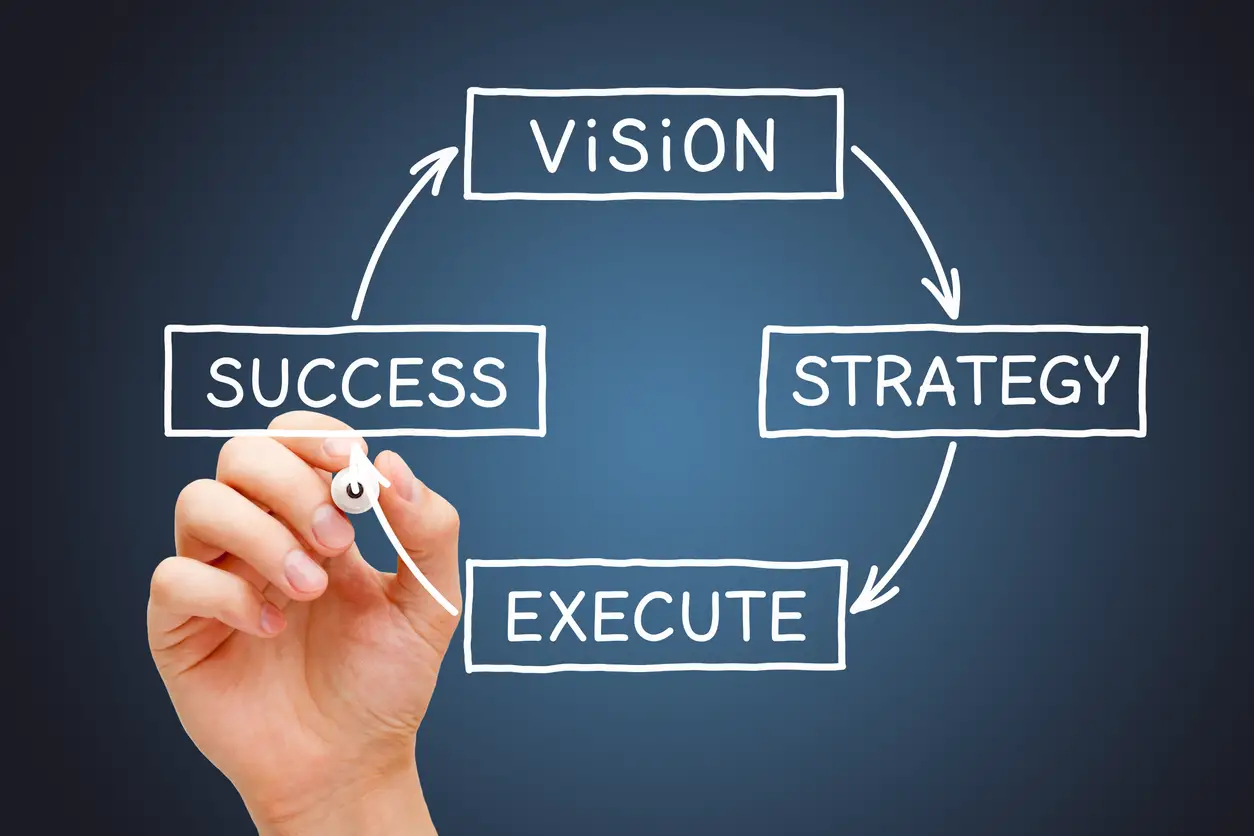Strategic thinking is a critical skill for any organization aiming to achieve success in today’s dynamic business environment. It involves the ability to visualize the future, identify trends, and predict potential problems, while also developing innovative solutions and effective strategies to achieve a company’s vision. This kind of thinking enables organizations to adapt to ever-changing circumstances and remain competitive.

To effectively incorporate strategic thinking, organizations must have a clear understanding of their vision and goals, as well as a comprehensive evaluation of their internal and external factors. This requires leaders to analyze various elements such as market trends, competitor positioning, and available resources and capabilities. By considering these factors, organizations can engage in proactive decision-making, enabling them to identify opportunities, mitigate risks, and drive innovation.
Key Takeaways
- Strategic thinking is crucial for organizations to adapt and stay competitive
- An in-depth assessment of internal and external factors is critical for effective strategy development
- Proactive decision-making and innovation are key aspects of strategic thinking
Understanding Strategic Thinking

Strategic thinking is a critical skill that enables individuals and organizations to plan for the future by analyzing situations, identifying patterns, and anticipating potential outcomes. To develop a strategic mindset, one must cultivate several core competencies and abilities that distinguish strategic thinkers from conventional thinkers.
First and foremost, strategic thinkers possess a long-term perspective. They’re able to move beyond day-to-day problem-solving and consider the broader implications of their actions and decisions. This ability to embrace a wider vision allows these individuals to focus on the future success of an organization, rather than narrowly concentrating on immediate concerns.
One of the fundamental strategic thinking skills is recognizing the importance of flexibility and adaptability. Strategic thinkers understand that the business environment is constantly changing, and they are constantly refining their plans to fit their evolving surroundings. They are prepared to pivot when necessary and willing to abandon outdated methods in favor of more effective approaches.
To achieve this level of flexibility, strategic thinkers must possess an inquisitive mind. They aren’t afraid to question or challenge conventional thinking and explore new avenues of thought and action. By consistently reassessing their assumptions and beliefs, strategic thinkers are better equipped to identify opportunities and threats, both internal and external to their organization.
Moreover, strong strategic thinkers have the ability to synthesize information from various sources, analyzing data and weighing different perspectives in order to arrive at a comprehensive understanding of a situation. This integration of information helps them to make informed decisions that take into account the potential impact of their actions on others.
Another crucial aspect of a strategic mindset is possessing good communication skills. Strategic thinkers must be able to articulate their ideas and plans effectively in order to gain buy-in from others, foster collaboration, and inspire action. Clear communication of strategic goals and objectives is essential for aligning the efforts of all team members and ensuring that everyone is working toward the same end.
In summary, understanding strategic thinking requires an appreciation of the key distinguishing factors that set strategic thinkers apart from their more conventional counterparts. These include a long-term perspective, adaptability, an inquisitive nature, information synthesis, and clear communication. By developing these characteristics, individuals can contribute meaningfully to the long-term success of their organizations.
Process of Strategic Thinking

Strategic thinking is a critical skill necessary for leaders and managers to face complex business challenges and find effective solutions. The process of strategic thinking encompasses several important aspects like analysis, strategic planning, decision-making, and problem-solving. In this section, we will explore these components and how they form the backbone of strategic thinking.
Analysis is the foundation of strategic thinking. It involves evaluating the current situation, identifying patterns, and understanding the potential implications of various actions or decisions. Leaders and managers must analyze various inputs, such as financial statements, market conditions, and emerging business trends, to make informed decisions. Analytical skills help in creating strategies that align with the organization’s long-term objectives.
Strategic planning is another important aspect of strategic thinking. It requires one to move beyond day-to-day problem-solving and adopt a broader, long-term perspective. A well-defined strategy should include specific goals, action plans, and necessary resources. The six-step process for strategic thinking provides a helpful framework for creating strategic plans:
- Understand the present
- Define the future
- Determine the path
- Assess the risks
- Develop plans and contingencies
- Implement the strategy
Decision-making is a significant aspect of strategic thinking. Leaders and managers must evaluate different options, consider possible outcomes, and make decisions that align with their organization’s overall vision and goals. Using tools like flowcharts and scenario planning can help streamline the decision-making process by providing a clear and structured approach.
Problem-solving is another important aspect of strategic thinking. It involves identifying issues, generating alternative solutions, and choosing the best course of action. Effective problem-solving requires both an in-depth understanding of the situation and the ability to think outside the box. Leaders with strong strategic thinking skills are known for their ability to question conventional thinking and challenge the status quo.
In conclusion, the process of strategic thinking involves a combination of analysis, strategic planning, decision-making, and problem-solving. By mastering these components and effectively utilizing tools like flowcharts and scenario planning, leaders and managers can create well-rounded strategies that drive their organizations toward long-term success.
Role of Leadership in Strategic Thinking
Leadership plays a pivotal role in the development and execution of strategic thinking within an organization. The level of commitment and involvement from leaders, whether it be executives or managers, can greatly affect how well the organization embraces and benefits from a strategic mindset.
Strong leaders understand the importance of actively engaging in strategic thinking, analyzing the bigger picture, anticipating challenges, and making decisions aligned with the organization’s long-term goals. One way leaders can achieve this is by incorporating leadership development initiatives within the organization, designed to foster a culture of strategic thinking and collaboration among team members.
An important aspect of leadership in strategic thinking is the ability to communicate clearly and convey the organization’s vision and strategy to others. Leaders must be confident, knowledgeable, and able to inspire their teams to align with and contribute towards the overall strategic direction. This can be achieved through regular discussions, meetings, and workshops, specifically tailored to address the organization’s objectives and foster critical thinking among team members.
In addition to these efforts, leaders may also consider utilizing executive coaching services to further enhance their strategic thinking capabilities, as well as those of their team members. Executive coaching can provide valuable insights and practical guidance for leaders in refining their strategic approach, helping them to navigate complex decision-making processes and anticipate future challenges.
Moreover, effective leaders must foster an environment that encourages employees to take the initiative and contribute their ideas. Engaging employees in strategic thinking allows the organization to capitalize on the diverse perspectives and experiences, ultimately leading to more innovative solutions and a stronger strategic stance.
In summary, the role of leadership in strategic thinking involves driving the organization’s strategic vision, fostering a culture that encourages strategic thinking among all team members, and continuously nurturing leadership development initiatives. By taking these steps, leaders can empower their organizations to make informed decisions, better navigate challenges, and ultimately achieve long-term success.
Barriers and Overcoming them
Strategic thinking involves comprehensive planning and analytical decision making. However, several factors can hinder the development and implementation of effective strategies. In this section, we will discuss common barriers to strategic thinking and ways to overcome them.
Cognitive biases and assumptions are inherent in the human thought process and can negatively impact strategic thinking. They could lead to distorted decision-making, overgeneralizations, and assumptions based on incomplete information. To mitigate the effects of biases and assumptions, it is essential to actively challenge your thought patterns and seek diverse perspectives from your team members. Regularly review and revise your strategies to stay open to new information and insights.
Lack of collaboration can lead to a narrow perspective in identifying opportunities and tackling challenges. Encouraging teamwork and collaborative problem-solving skills are critical in broadening the organization’s strategic viewpoint. This can be achieved by involving teams with diverse backgrounds and experiences in strategy development workshops or brainstorming sessions. Regularly scheduled meetings to revisit the ideas and refine them can also promote collaborative environments.
Difficulty in prioritizing can cause strategic thinking to lose focus. It is critical to establish clear goals and objectives, which will guide the strategic planning process. One way to establish priorities is through using effective time management tools such as task-tracking software or to-do lists. Explicitly stating the objectives and assigning priorities to them can create transparency and ensure that all team members are on the same page.
Developing problem-solving skills is crucial for overcoming barriers in strategic thinking. Emphasize on strengthening these skills by incorporating critical thinking exercises, simulations, and real-world case studies in your team’s professional development initiatives. Encouraging regular feedback and reflection can also help identify areas of improvement in problem-solving capabilities.
Adapting to change is another aspect of strategic thinking that can often be challenging. As new information becomes available or the environment changes, the strategies should evolve accordingly to address the new circumstances. Cultivate agility in your team by fostering a culture that embraces change and is always ready to learn, adapt, and grow.
In summary, recognizing the barriers to strategic thinking and finding ways to overcome them can lead to more refined and effective strategies. By addressing cognitive biases, promoting collaboration, honing problem-solving skills, and adapting to change, you can develop a more resilient and agile organization ready to succeed in a competitive landscape.
Impact and Benefits of Strategic Thinking
Strategic thinking is a crucial skill in today’s business world, as it enables organizations to navigate the challenges and opportunities they face while pursuing growth and long-term success. In this section, we will discuss the impact and benefits of strategic thinking across a range of areas, including competitive advantage, goal-setting, and strategic management.
One of the most significant benefits of strategic thinking is the ability to gain a competitive advantage. By analyzing the market, identifying opportunities, and anticipating potential outcomes, organizations can devise strategies that set them apart from competitors and capitalize on market trends. Engaging in strategic thinking allows for a more robust understanding of the competitive landscape, leading to better decision-making and increased agility in response to changes in the industry.
Strategic thinking also fosters goal-setting by guiding organizations to establish specific goals that align with their overall vision and mission. This process involves analyzing both internal and external factors, as well as understanding patterns within the organization and the market. By setting clear, well-defined goals, companies can focus their efforts on activities that drive growth and enhance value.
Strategic management is a discipline that relies heavily on strategic thinking skills. This practice involves the development and implementation of strategic plans by coordinating resources, monitoring progress, and adapting strategies when necessary. Effective strategic management enables companies to maintain control over their activities and execute strategies in a manner that optimizes efficiency and promotes growth.
An important aspect of strategic thinking is its ability to create a long-term perspective, which can improve a company’s chances of long-term success. This mindset encourages organizations to look beyond short-term gains and consider the future impact of their actions and decisions. By adopting a long-term perspective, companies can identify sustainable growth opportunities, foster innovation, and develop resilience to withstand market fluctuations.
In summary, strategic thinking has a wide-ranging impact on businesses, providing them with a competitive advantage, guiding goal-setting, and supporting strategic management. Embracing this skillset promotes growth, long-term success, and a heightened ability to navigate the complexities of the modern business environment.





